Eshmoun |
A UNIQUE PHOENICIAN SITE IN
LEBANON |
| The Temple of Eshmoun, less then an hour from Beirut, is situated one Kilometer from Sidon in a lush valley of citrus groves on the Awwali River. The site is known locally as “Bustan esh-Sheikh.” Whether you visit in spring when the air is fragrant with blossoms, or early winter when the fruit is ripe, Eshmoun is special. |

Aerial view of the site |
This Phoenician Temple complex, dedicated to the healing god Eshmoun, is the only Phoenician site in Lebanon that has retained more than its foundation stones. Building was begun at the end of the 7th century B.C. and later additions were made in the following centuries. Thus, many elements near the original temple site were completed long after the Phoenician era, including the Roman period colonnade, mosaics, a nymphaeun, and the foundations of a Byzantine Church. All of these buildings testify to the site’s lasting importance. |
| Eshmoun can be included in a visit to Sidon, or made an excursion of its own. Visitors with a sense of curiosity will find that several hours are easily filled exploring this ancient Phoenician spa. |
THE HISTORY OF
Eshmoun |
Legend has it that Eshmoun was a young man of Beirut who loved to hunt. The goddess Astarte fell in love with him, but to escape her advances he mutilated himself and died. Not to be outdone, Astarte brought him back to life in the form of a god. It is also said that the village of the young god’s tomb. Known primarily as a god of healing, Eshmoun’s death and resurrection also gave him the role of a fertility god who dies and is reborn annually. |
As the god of healing, Eshmoun was identified with Asklepios, the Greek god of medical art. It is from belief in the healing power of Eshmoun-Asklepios and the snake that we get the sign of the medical profession that is now used worldwide. Our modern caduceus, a staff interview is derived from these symbols. The caduceus can be seen in a gold plaque of Eshmoun and the goddess Hygeia (Health) which was found near the temple. It shows Eshmoun holding in his right hand a staff around which a serpent is entwined. There is also an early 3rd century A.D. Beirut coin depicting Eshmoun standing between two serpents. |
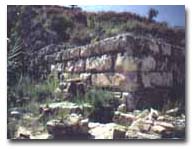 The southwest angle of the persian podium or Monumental platform |
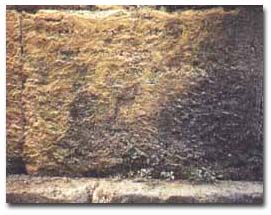 Phoenician inscription |
Each Phoenician city-state had its own gods, and Eshmoun was one of the favorites of Sidon. The site of his temple must have been chosen because of the nearby water source, which was used in the healing rituals. It was the custom to offer statues to the god that bore the names of those who came for healing. The fact that most of these votive pieces depict children suggests that eshmoun may have been regarded as the pediatrician of the times. |
| During the Persian era, between the 6th and 4th centuries B.C, Sidon was the first Phoenicia city to be noted for the opulence of its kings, the advanced culture of its intelligentsia and the excellent reputation of its industry. The Persian kings held the kings of Sidon in great regard and granted them many rewards, especially for the Sidonian fleet’s active participation on their side during their wars against Egyptians and Greeks. |
| It was at that time that Eshmounazar II, the son of Tabnit I, acceded to the throne. Inscriptions found on the sarcophagus of Eshmounazar (discovered in 1858 and now in the Louvre Museum) relate that he and his mother Amashtarte (servant of Astarte) built temples to the god of Sidon. One of these was the temple of the Holy God “Eshmoun at the source of Yidlal near the cistern.” | 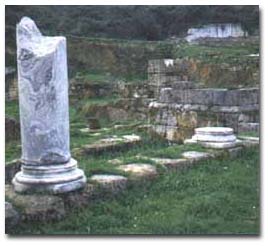 Roman colonade |
| The temple of Eshmoun built by Eshmounazar II and rediscovered in the century during the excavations at Boustan esh-Sheikh, was destroyed around the middle of the fourth century B.C. Although the temple was never rebuilt, some small buildings, chapels and pools were restored. This allowed visitors, pagan as well as Christian, to attend the sanctuary. The site remained popular until the end of the third century A.D., even though it was largely in ruins and littered with debris. |
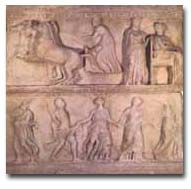 "Tribune of Eshmoun"... National Museum of Beirut |
THE EXCAVATIONS For centuries before its excavation, the site of the Temple of Eshmoun was used as a quarry. Emir Fakhreddine, for example, used its massive blocks to build a bridge over the Awwali River in the 17th century. Today only the foundations of this bridge remain. |
In 1900, an Ottoman expedition found Phoenician inscriptions in the area of the yet undiscovered temple. Twenty years later successful soundings were made on the site and in 1925-26 excavations near the river uncovered the Roman mosaic floor and several marble statuettes of children dating to the Hellenistic period (330-64 B.C.). Another inscription in Phoenician letters bearing the name Eshmoun was found near the river a short time later. A few kilometers from the site inscriptions bearing the name of Bodashtart were found, probably incised on the occasion on the completion of an important canal system. |
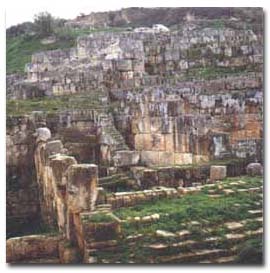 View showing various levels of construction |
Although the land around the site was purchased in the mid-1940’s serious excavation work did not begin until 1963. |
VISITING THE SITE |
The most imposing ruin at Eshmoun id the temple, or temple complex (numbers 1-9 on the plan). An overall view of Eshmoun can be had by climbing the mosaic-covered Roman stairway (13). The approach to the temple site is along a Roman colonnaded road (10). On the right is a massive capital with four carvings of bulls’ heads (12), which go back to the Persian period. They were placed here at a later date in a shrine set up in the courtyard of the temple. |

Detail of the mosaic of four Seasons |
The oldest section is a pyramid-shaped structure with a short flight of stairs on its summit and a wall to its right (1) dating from the 6th century B.C., when Phoenician city-states were under the political and cultural influence of Babylon. The second and largest podium (2) was built by the Sidonian King Eshmounazar in the 5th century B.C. and probably enlarged later by a King Bodashtart whose inscriptions can still be seen on one of the inner slabs of the massive retaining walls of the temple. |
The site’s healing waters were channeled through a canal system (3) to the sacred basins (4, 5, 6, 9, 11). Another temple was added in the 3rd century B.C. (7). You can still see part of the original frieze representing worshippers, hunting scenes, and children’s games. Near the far northwest angle of the temple is a sanctuary of Venus/Astarte (8), also from the Hellenistic period. Inside this small area measuring 11 x 10 meters, is a throne flanked by two sphinxes, which is known as the “Throne of Astarte.” The throne stands on a single block of stone with a cornice sculptured in the Egyptian style. A frieze, unfortunately very mutilated, depicts a hunting scene. |
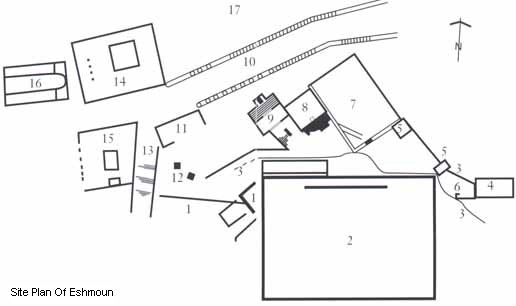 |
|
|
A later addition to the temple is a small mosaic room guarded by a now headless sphinx. An inscription dates this section to 335 A.D. To the left of the pool stands a 22-meter-long wall with reliefs of drunken revelry and a man attempting to seize a large plumed cock. It was apparently common practice among the Greeks to sacrifice cocks to Asklepios (Eshmoun). |
During the Roman and early Christian eras (64 B.C. to 330 A.D.) the site of the Temple of Eshmoun and its miraculous waters continued to serve as a place of pilgrimage. Within the Phoenician temple site the Romans added the processional stairway (13), basins for ablutions and a nymphaeun with pictorial mosaics, largely still intact (15). Worn statuettes of three nymphs stand in the niches of the fountain. On the left side of the Roman road, opposite the temple complex, is a courtyard with the remains of mosaics depicting the Four Seasons (14). To the left of the Roman courtyard are the foundations of a Byzantine period basilica, the last major period represented at Eshmoun (16). |
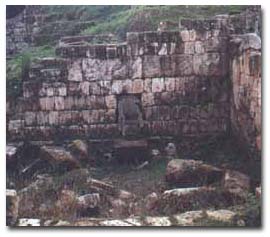
The throne of Astrate, flanked by two sphinxes |
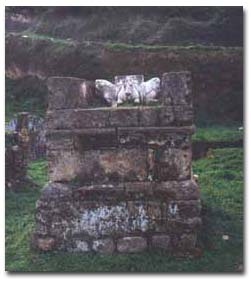 Shrine with a capital of bull protomes |
THE SITE TODAY There are no concessions or facilities at the site. However, the visit is just minutes from Sidon where the government Rest House, located near the Sea Castle, serves meals 12:00 to 4:00 pm and 7:00 to 12:00 midnight. |
| Information Collected From The Ministry of Tourism |